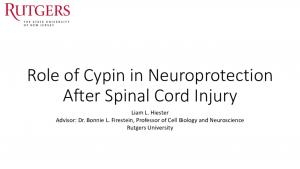Hiester, Liam: Role of Cypin in Neuroprotection After Spinal Cord Injury

Title: Role of Cypin in Neuroprotection After Spinal Cord Injury
Name: Liam Hiester
Major: Cell Biology and Neuroscience
School affiliation: Honors College, School of Arts and Sciences
Programs: Aresty – Research or Conference Funding Recipient, Honors College Capstone
Other contributors: Bonnie L. Firestein and Nisha Singh
Abstract: Video Link: https://youtu.be/rqgSsHwdSLc
Uric acid (UA; 7,9-dihydro-1H-purine-2,6,8(3H)-trione) is a product of purine metabolism. However, aberrant UA production can result in disease. High levels of UA result in gout, hypertension, and cardiovascular disease in the human body. Conversely, low levels correlate with neurodegenerative diseases, such as multiple sclerosis, Parkinson’s Disease, Alzheimer’s Disease, and cancer. Current treatments maintain UA levels by inhibiting the last two steps of UA synthesis, i.e. preventing the metabolism of hypoxanthine to xanthine and xanthine to UA. Cytosolic postsynaptic density-95 (PSD-95) interactor (cypin), the primary guanine deaminase in the central nervous system (CNS), initiates the guanine salvage pathway to produce UA, and UA acts to increase pain, presumably by acting on toll-like receptors. Thus, cypin is an attractive target for therapeutics for spinal cord injury (SCI). Unpublished data show that inhibition of cypin enzymatic activity decreases pain hypersensitivity in mice after SCI, suggesting that cypin modulation may be a viable therapeutic approach for neuropathic pain. Our study aims to identify whether modulation of cypin, using small molecule cypin inhibitors and activators, is neuroprotective in rat sensory spinal cord neurons in response to glutamate-induced excitotoxicity in primary cultures. Our data suggest that inhibition of cypin before or after glutamate-induced injury maintains neuronal viability and decreases cypin protein expression. This study will further our understanding of the potential therapeutic value of cypin modulation in maintaining proper health and function in sensory spinal cord neurons after injury.